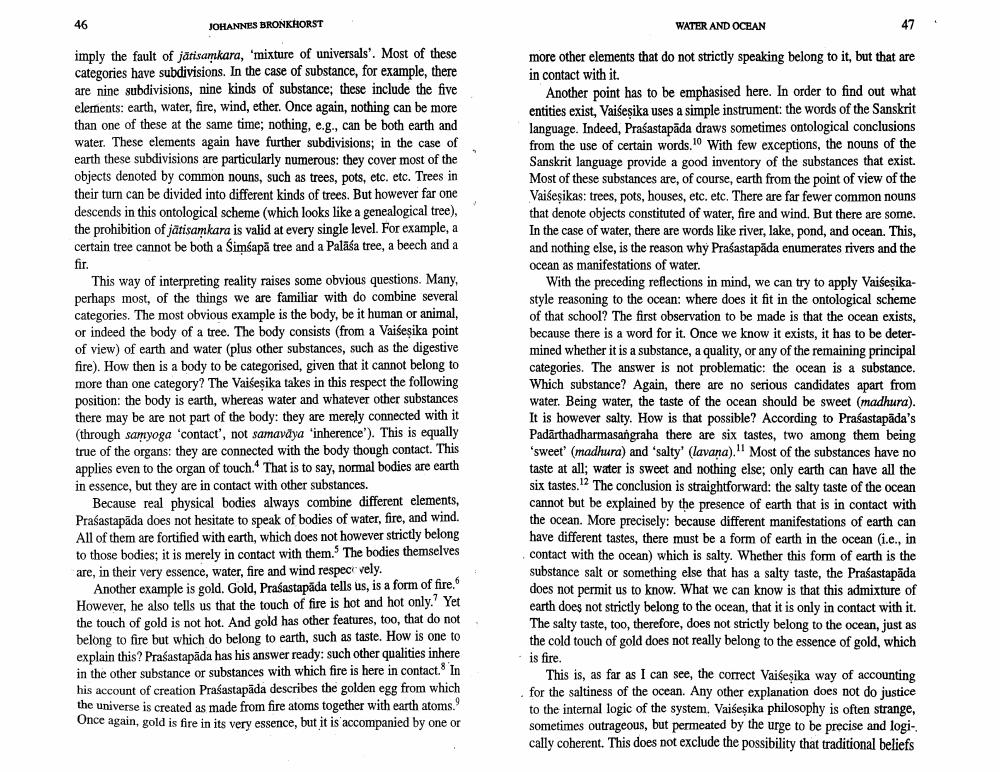________________
JOHANNES BRONKHORST
WATER AND OCEAN
47
.
imply the fault of jatisarkara, 'mixture of universals'. Most of these categories have subdivisions. In the case of substance, for example, there are nine subdivisions, nine kinds of substance; these include the five elements: earth, water, fire, wind, ether. Once again, nothing can be more than one of these at the same time; nothing, e.g., can be both earth and water. These elements again have further subdivisions; in the case of earth these subdivisions are particularly numerous: they cover most of the objects denoted by common nouns, such as trees, pots, etc. etc. Trees in their turn can be divided into different kinds of trees. But however far one descends in this ontological scheme (which looks like a genealogical tree), the prohibition of jätisamkara is valid at every single level. For example, a certain tree cannot be both a Simšapā tree and a Palasa tree, a beech and a fir.
This way of interpreting reality raises some obvious questions. Many, perhaps most of the things we are familiar with do combine several categories. The most obvious example is the body, be it human or animal, or indeed the body of a tree. The body consists (from a Vaišesika point of view) of earth and water (plus other substances, such as the digestive fire). How then is a body to be categorised, given that it cannot belong to more than one category? The Vaiseșika takes in this respect the following position: the body is earth, whereas water and whatever other substances there may be are not part of the body: they are merely connected with it (through samyoga 'contact', not samavdya 'inherence'). This is equally true of the organs: they are connected with the body though contact. This applies even to the organ of touch. That is to say, normal bodies are earth in essence, but they are in contact with other substances.
Because real physical bodies always combine different elements, Prasastapäda does not hesitate to speak of bodies of water, fire, and wind. All of them are fortified with earth, which does not however strictly belong to those bodies; it is merely in contact with them. The bodies themselves are, in their very essence, water, fire and wind respec vely.
Another example is gold, Gold, Prasastapada tells us, is a form of fire. However, he also tells us that the touch of fire is hot and hot only. Yet the touch of gold is not hot. And gold has other features, too, that do not belong to fire but which do belong to earth, such as taste. How is one to explain this? Prasastapāda has his answer ready: such other qualities inhere in the other substance or substances with which fire is here in contact. In his account of creation Prasastapäda describes the golden egg from which the universe is created as made from fire atoms together with earth atoms. Once again, gold is fire in its very essence, but it is accompanied by one or
more other elements that do not strictly speaking belong to it, but that are in contact with it.
Another point has to be emphasised here. In order to find out what entities exist, Vaiseșika uses a simple instrument: the words of the Sanskrit language. Indeed, Prasastapāda draws sometimes ontological conclusions from the use of certain words. With few exceptions, the nouns of the Sanskrit language provide a good inventory of the substances that exist. Most of these substances are, of course, earth from the point of view of the Vaiseşikas: trees, pots, houses, etc. etc. There are far fewer common nouns that denote objects constituted of water, fire and wind. But there are some. In the case of water, there are words like river, lake, pond, and ocean. This, and nothing else, is the reason why Prasastapāda enumerates rivers and the ocean as manifestations of water.
With the preceding reflections in mind, we can try to apply Vaišeşikastyle reasoning to the ocean: where does it fit in the ontological scheme of that school? The first observation to be made is that the ocean exists, because there is a word for it. Once we know it exists, it has to be determined whether it is a substance, a quality, or any of the remaining principal categories. The answer is not problematic: the ocean is a substance. Which substance? Again, there are no serious candidates apart from water. Being water, the taste of the ocean should be sweet (madhura). It is however salty. How is that possible? According to Prasastapāda's Padārthadharmasangraha there are six tastes, two among them being 'sweet' (madhura) and 'salty' (lavana)." Most of the substances have no taste at all; water is sweet and nothing else; only earth can have all the six tastes. The conclusion is straightforward the salty taste of the ocean cannot but be explained by the presence of earth that is in contact with the ocean. More precisely: because different manifestations of earth can have different tastes, there must be a form of earth in the ocean (i.e., in contact with the ocean) which is salty. Whether this form of earth is the substance salt or something else that has a salty taste, the Prasastapāda does not permit us to know. What we can know is that this admixture of earth does not strictly belong to the ocean, that it is only in contact with it. The salty taste, too, therefore, does not strictly belong to the ocean, just as the cold touch of gold does not really belong to the essence of gold, which is fire.
This is, as far as I can see, the correct Vaišeşika way of accounting for the saltiness of the ocean. Any other explanation does not do justice to the internal logic of the system. Vaiseșika philosophy is often strange, sometimes outrageous, but permeated by the urge to be precise and logically coherent. This does not exclude the possibility that traditional beliefs




